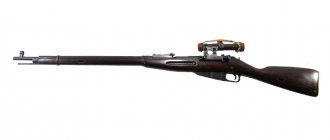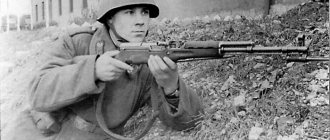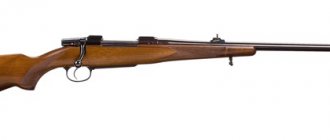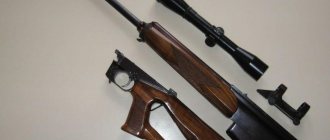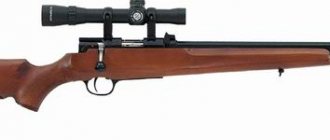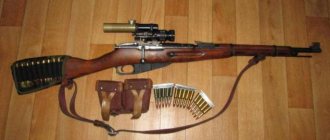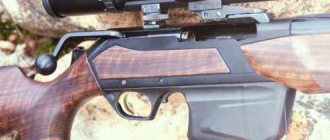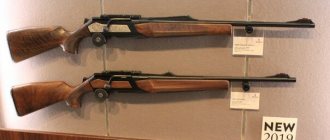Description of the rifle
For a short stroke of the gas piston, powder gas is used, which is removed from the barrel channel. A regulator is installed in the chamber to change the amount of gases released, which affects the use of the rifle in different circumstances and allows you to change the conditions for using different types of cartridges.
The piston transmits movement to the bolt, and the spring returns it back. The barrel channel is locked with a bolt that tilts in a vertical plane. There is another spring in the barrel box, which serves to return the bolt on the frame to the reverse position. The rifle has a composite stock; the mechanism is released by a trigger. The trigger mechanism is blocked by a fuse.
Working in combat
The magazine is loaded without removing the clips from the rifle. Sighting is carried out with a front sight and a muzzle. The SVT-40 sniper rifle with a PU optical sight has a brake in the barrel muzzle. The later modification has a muzzle mechanism similar to the AVT-40, and a bayonet-knife that looks like a blade for wearing in a special sheath on a waist belt.
If shooting is done from a prone position, then the weapon is supported by the left hand and is placed on the palm in front of the magazine. Using a rifle from a sitting, standing, or kneeling position involves holding the weapon by the magazine. A well-trained shooter fires about 25 shots per minute if the magazine is first filled. If you fill the magazine with two clips, then the number of shots is reduced to 20 per minute.
Types of modifications
- The SVT-38 was produced before 1940 and is characterized by a mass that is 500 grams greater than the next model. Its bayonet has not yet undergone lightening changes; the stock has the originally created shape.
- The SVT-40 is already an improved type with a shortened shield, and begins mass production in 1940. It is distinguished by increased reliability, lighter than the previous version by 600 grams.
- The SVT-40 sniper rifle, the characteristics of which allow for targeted fire, was put into production in 1940. It is distinguished by the presence of a special stop for installing an aiming device and more advanced processing of the barrel surface.
- The AVT-40 is an automatic variant with minor improvements to the trigger mechanism; the appearance is reminiscent of the basic SVT-38 model. Despite the efforts of the designers, it was not possible to create a reliable automatic rifle, and the production of such weapons was curtailed in 1942.
- The AKT-40 is an automatic carbine that is not used in the army, although it is intended for targeted automatic fire.
- The SVT-O is a hunting type weapon, converted from the SVT-40 weapon, which was withdrawn from the army mobilization reserve. Today the product is presented in the form of a weapon for single shooting. Available to the general public since 2012.
In conclusion, it should be noted that for the production and improvement of the design of the rifle, not very successful war years are chosen; bets are placed on the quantity of weapons, and not on their quality. If this had happened in peacetime, then better shooting weapons would have been produced based on the rifle.
KO-40 from AVT-40 (Tokarev automatic rifle model 1940)
The Okhotnichiy carbine (KO-40) has been produced for several years by several Russian weapons versions of the Tokarev self-loading rifle of the 1938 or 1940 model (SVT-38 or SVT-40) or the Tokarev automatic rifle of the 1940 model (AVT-40). However, only in the last year and a half have “fenced” AVT-40s of “zero” or “first” storage categories been going on sale, that is, practically new, unfired and not used in military units.
KO-40 produced by TOZ are converted from rifles manufactured in 1944 and later. Externally, the KO-40 differs from the AVT-40 only in the increased size of the fuse box and laser-applied markings.
The AVT-40 fuse box is also a fire switch. When turned all the way to the left, it unlocks the trigger of the rifle, which allows you to fire single shots from the weapon. A flag installed in a vertical position does not allow you to squeeze the trigger and fire a shot. And, turned all the way to the right, the flag activates the self-release of the trigger for firing continuously or in bursts.
To comply with the requirements of the Federal Law “On Weapons” in terms of preventing burst fire from civilian weapons, the safety box is elongated and when trying to set it to the extreme right position, it rests against the rifle trigger.
In all other respects, the appearance of the KO-40 fully corresponds to the AVT-40. The rifle has a factory blued finish and a stock installed back in 1944.
The only drawback of all KO-40s entering the Russian hunting weapons market is that the rifle is equipped with only one magazine and the lack of accessories for the weapon.
Note that the magazine is adjusted manually to the SVT and AVT. The last three digits of the rifle number are marked on the side wall of the magazine. An additional magazine is very expensive and will most likely require adjustment. However, the KO-40 (as well as SVT and AVT) can be loaded using regular clips from a Mosin rifle (clips are purchased separately). Once all the cartridges have been used up, the bolt remains in the rearmost position on the bolt stop. Moreover, if you insert a clip from a Mosin rifle into the grooves of the receiver cover and press on the upper cartridge, then all five cartridges will go into the magazine. Two clips and the magazine is full. That is, you can load the rifle without unlocking the magazine from the weapon.
It is much more difficult to purchase a rather rare wrench for adjusting a gas engine, but it can be replaced with a small “4” wrench.
During the Great Patriotic War, the SVT-40 and AVT-40 were quite advanced weapons chambered for the powerful 7.62*53 rifle cartridge (now this cartridge is designated 7.62*54R). Despite the automatic operation and a very powerful cartridge, the weapon turned out to be quite light.
The receiver of the rifle is milled from a solid steel billet. Locking is carried out by tilting the shutter. The gas outlet unit acts through a pusher on the lightweight (by cartridge power standards) bolt and bolt frame. This ensures a reduction in weapon resonance from sudden movement of moving parts, which has a positive effect on shooting accuracy. Some of these features inherent in the design of the SVT and AVT will subsequently become characteristic of the later Dragunov sniper rifle of the 1963 model.
The small mass of moving parts and the small mass of the rifle itself with such a powerful cartridge is ensured by the special design of the chamber with Revelli longitudinal grooves. These grooves facilitate the extraction (ejection) of a spent cartridge case with a low mass of moving parts, whose breaking speed is very high. With the help of Revelli grooves, the risk of transverse rupture of the cartridge case or tearing of the ejector tooth from the cartridge flange is reduced.
To reduce recoil, the AVT-40 uses a single-chamber muzzle brake.
Therefore, even in the 21st century, the KO-40, converted from the AVT-40, is an effective self-loading weapon chambered for a powerful rifle cartridge, while being quite light and elegant. Today, the KO-40 is the most affordable self-loading hunting rifle chambered for 7.62*54R. We offer KO-40 from the new AVT-40 from the warehouses of the Russian Ministry of Defense produced by TOZ for only 33,880 rubles.
Characteristics of a self-loading rifle
During the Finnish-Soviet war in 1939-1940, the SVT-40 sniper rifle was used for the first time. Characteristics and technical indicators:
- rifle caliber - 7.62;
- the weapon weighs 3.8 kg without a bayonet and cartridges;
- cartridge caliber – 7.62x54 mm;
- rifle length – 1 m 23 cm;
- standard rate of fire is from 20 to 25 rounds per minute;
- initial bullet speed – 829 meters per second;
- sight range – up to 1.5 km;
- The magazine holds 10 rounds of ammunition.
Muffler application
The SVT-40 sniper rifle with a silencer is being tested at a training ground in the spring of 1941. The device is designed only for bullets with supersonic speed, and it is not suitable for rifle ammunition with reduced speed. This design of the silencer does not change the speed and combat accuracy of a given bullet, but the sound of the shot is almost not dampened, and the brightness of the flash remains the same.
The gases from the gunpowder after the shot do not leave the barrel, but are retained by the muffler, which leads to the fact that when the bolt is opened, they hit the shooter in the face with a dense stream. The device for silent shooting from a rifle was damaged during testing activities, and its design was no longer finalized.
SVT-40 sniper rifle and its use
Initially, it is planned that the self-loading rifle will be the main small arms of infantrymen and will greatly increase the power of aimed fire. According to the state, it is supposed to have several thousand of such weapons in each division, and the ratio of rifles with a self-loading mechanism and non-automatic devices was supposed to be brought to a ratio of 1:2.
By the beginning of the summer of 1941, about a million SVT-40 weapons were being manufactured. The sniper rifle received not only positive reviews from hunters. Most of the weapons were concentrated in the western districts of the border zone. At the same time as these rifles, the American M1 Garand was produced, which is equal in functionality to the Soviet version.
German gunsmiths used captured samples of Soviet rifles and put them into service with the army, since they did not have similar products. The middle of World War II was marked by the fact that the Germans were developing and producing a rifle, the details of which were reminiscent of the SVT-40. In the Soviet Union, the production of self-loading rifles is decreasing, and soon it is completely stopped. The complexity of production and the large number of structural parts make production expensive and unpromising. The 143-piece rifle contains 22 springs. Several types of special steels are used in the manufacture of components.
Disadvantages of a self-loading rifle
The SVT-40 sniper rifle is not widely used in the army due to the complexity of the design, which creates difficulties for manufacturing in production and during operation in combat conditions. The requirement for constant maintenance cannot be met under conditions of mass conscription in wartime. The disadvantages include an incompletely developed gas supply regulation system and the possibility of losing a removable magazine, and the inconvenient design contributes to contamination and dust.
The desire to reduce weight leads to malfunctions in the automatic mechanisms of the SVT-40. The sniper rifle retains its dimensions, but the weight is reduced due to the use of thinner parts and an increase in the number of holes in the casing, which leads to additional contamination.
Positive weapon characteristics
Despite unflattering reviews of the SVT-40, the sniper rifle has a number of advantages. The lightweight design made it possible to maneuver maneuverably in battle conditions and during forced marches. The sniper rifle differs from its ancestor SVT-40 in the 3.5x PU sight, which is lightweight (only 270 g). The sight mount allows shooting at a distance of up to 600 m.
The achievement of self-loading weapons is the increased rate of fire compared to the Mosin rifle. Ease of use allows you to receive recoil into your shoulder when firing, rather than catching a tossed barrel.
History of creation
The desire to turn a conventional weapon into an automatic analogue leads to the fact that Fedor Tokarev begins to produce the SVT-38 rifle, which during the war with the Finns undergoes a harsh test school. Use in combat conditions allows you to identify all the shortcomings of the weapon. These include heavy weight, operational failures, susceptibility to contamination and low air temperature readings, as well as the need for constant use of lubricant.
The designer is tasked with making a lighter rifle and reducing its dimensions, while increasing reliability and strength. Gunsmiths do not reduce the linear size of parts, which can lead to disruptions in the operation of the automation. They go by making thinner parts, reducing the length of the bayonet, and the magazine, casing and forend undergo design changes. The SVT-40 sniper rifle appears. The photo below shows the changes in the design.
In 1940, a self-loading rifle entered service with the army. The product has received the required characteristics, light weight, but the production of parts is carried out at the utmost level, the rifle parts are sensitive to manufacturing accuracy and compliance with technological rules. Weapons require complex maintenance, which is not always provided in combat conditions.
